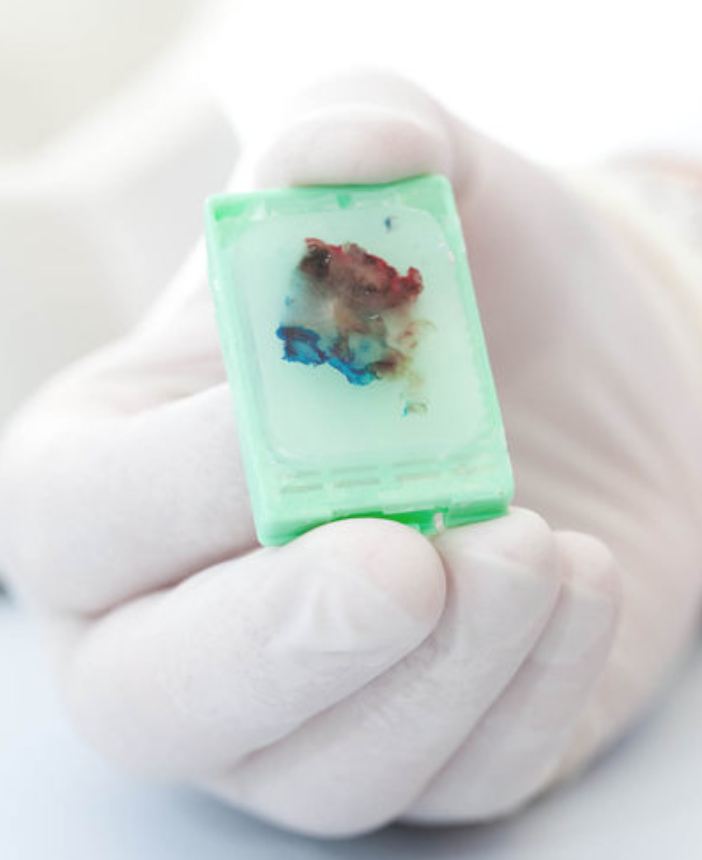Introduction
Formalin-fixed paraffin-embedded (FFPE) is a method that is used to preserve tissue samples that are extensively used in various research. It helps to preserve the cellular details and morphology of the tissue samples. Over the years, it has since become the standard preservation procedure due to its cost-effectiveness for long-term storage at ambient temperatures compared to frozen tissue that has to be stored at ultra-low temperatures. Due to this advantage, pathology departments have started routinely archiving vast numbers of FFPE tissue samples compared to frozen tissues. This means that paraffin-embedded tissue is an untapped resource of an extensive repository of tissue material. It provides a valuable resource for many researchers, especially in translational clinical research.
The FFPE Process
The process begins when a specimen is selected and excised from the patient or donor. Tissues can be collected from non-diseased and diseased donors including animals for studies using animal models. Once excised, the tissue is immersed for an estimated eighteen to twenty-four hours in 10% neutral buffered formalin. This step is known as formalin fixing and is vital to help preserve the vital structures and protein available in the tissue. Once ready, the tissue is dehydrated using increasing concentrates of ethanol and embedded into paraffin wax blocks to become FFPE blocks. Since there are no standard protocols for the FFPE process, the methods utilized depends on the requirements of the physician or researcher requesting the tissue samples. Once complete, the paraffin block is sectioned and mounted on a microscopic slide to be examined by a certified pathologist to evaluate the quality of the specimen.
FFPE Tissue Applications
FFPE tissues are often used in immunohistochemistry (IHC). The tissue sections are mounted on a slide, bathed in a solution containing antibodies, and stained to help visualization of the antibodies. The stain helps to show the structures that are present in the tissue sample. This is important as it helps physicians that are looking for signs of diseases such as Alzheimer’s disease or cancer. The information obtained from IHC is also crucial to many cancer-based research projects that are ongoing today. Some of the fields that FFPE tissues are often used are:
Oncology – In oncology, FFPE tissues are crucial as the study of cancer involves searching for characteristic morphologies that are present in preserved tumor tissues. FFPE tissues are often useful as it enables researchers to look for specific proteins which can play a vital role in the diagnosis and assessment if a therapy is useful for treatment purposes. FFPE tumor tissues should contain at least 60% tumor unless indicated otherwise.
Immunology – In this field, the responses of the immune system for both diseased and healthy states are studied using FFPE tissue samples. Studying the samples from those with an autoimmune disease enables researchers to determine the cause of the autoimmune disease and develop the therapy for the patient.
Hematology – In hematology, FFPE tissue helps researchers to study blood and related disorders. Through the study of hematology, many cures have been discovered and developed due to the various anomalies found in various blood components. The hematology studies are also applicable to other fields such as genetics, tissue regeneration, and toxicology.
Disadvantages
Some of the possible disadvantages of FFPE tissues are the formaldehyde fixation process where some experts think that it denatures the proteins in the tissue making them invisible to antibody detection. However, to compensate for this issue, antigen retrieval techniques have been developed. Some recent techniques involve the recovery of DNA, RNA, and proteins from FFPE biospecimens. This has opened up even more possibilities for FFPE tissue as it enables it to be used for biochemistry and molecular biology studies. The quality of FFPE tissue will be crucial for this work as even the most well-preserved tissue still contains partially degraded DNA, RNA, and inactive proteins. Another issue is that there is no standard procedure available for the preanalytical processing of the FFPE samples. This may lead to minor differences such as sample handling, different instrument use, and methodology that can lead to differences in DNA quality and study results. Some factors that have been thought to affect study results are temperature during fixation, variation in fixation time, storage conditions of FFPE samples, and inaccurate logging of fixation protocol.
Quality Control
Since quality is of the utmost concern, those responsible for the collection and storage of FFPE samples should keep an accurate record of donors, follow ethical and legal standards, ensure there is supervision by a licensed pathologist during collection of samples, provide accurate information regarding the collection process, have a complete chain of custody for the samples, and work with a select network of distributors that only provide high quality samples.
Conclusion
FFPE samples have been successfully used in IHC. While FFPE samples are known to be poor for molecular biological applications, in the last decade, there is an exponential increase in the development of molecular assays. The advances in molecular biological techniques have also helped to overcome formalin cross-linking and resulted in successful extraction of DNA, RNA, and proteins despite being fragmented.
References:
Kokkat TJ, Patel MS, McGarvey D, LiVolsi VA, Baloch ZW. Archived formalin-fixed paraffin-embedded (FFPE) blocks: a valuable underexploited resource for extraction of DNA, RNA, and protein. Biopreserv Biobank. 2013; 11(2):101-106.
What are FFPE samples. Geneticist Inc. Accessed 10/7/2019. https://www.geneticistinc.com/blog/ffpe-samples
What is FFPE tissue and what are its uses. BioChain. Accessed 10/7/2019. https://www.biochain.com/general/what-is-ffpe-tissue/


